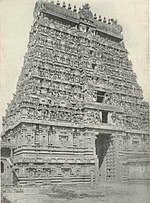Trichinopoly District
This article needs additional citations for verification. (November 2010) |
The Trichinopoly district was a
Trichinopoly was one of the oldest inhabited regions in South India. Archaeological excavations have revealed Stone Age sites.[citation needed] The town of Uraiyur, the capital of the Early Cholas, was a part of Trichinopoly district. The region was annexed to Madras Presidency in the late 18th century and a separate district was created in 1801. When India became independent in 1947, the name of the district was de-Anglicized as Tiruchirapalli.
History

Stone Age implements discovered in Trichinopoly district indicate that it might have been inhabited as early as the 3rd millennium BC.[
Administration
The Trichinopoly district was constituted in 1801 with Mr. Wallace as its first Collector. As of 1907, the district had three municipalities -
The Trichinopoly municipality was the oldest municipality in the district, established in 1866, followed by Srirangam in 1871 and Karur in 1874.

Sub-Divisions
As of 1901, Trichinopoly district was made up of seven taluks.
- Karur
- Kullittalai (930 sq. miles) - largest taluk in the district
- Musiri (667 sq. miles)
- Namakkal
- Perambalur (690 sq. miles)
- Trichinopoly (519 sq. miles)
- Udaiyarpalaiyam (777 sq. miles)
Perambalur taluk was initially a part of South Arcot district but was transferred to Trichinopoly. Namakkal taluk was transferred to Trichinopoly from Salem in 1910.
Demographics
| Year | Pop. | ±% |
|---|---|---|
| 1871 | 1,200,408 | — |
| 1881 | 1,215,033 | +1.2% |
| 1891 | 1,372,717 | +13.0% |
| 1901 | 1,444,770 | +5.2% |
Sources:
| ||
Trichinopoly had a population of 1,444,770 in 1901. In 1901, it was the seventh most densely populated district in the Presidency with a population density of 400 per square mile compared to the density of the Presidency which was 270 per square mile. The population of the district increased by 21 percent between 1871 and 1901.
Education
The literacy rate of Trichinopoly was higher than the average literacy rate of the Madras Presidency. According to the 1901 census, 13 percent of the male population and 0.8 percent of the female population were literate. As of 1907, there were two colleges, St. Joseph's and SPG in Trichinopoly town.
Economy
As of 1907, more than three-fourths of the total population was involved in agriculture. Trichinopoly was also an important silk-weaving centre while cotton clothes were manufactured at Karur, Udaiyarpalaiyam and Perambalur. Metal utensils were manufactured at Kullittalai, Permbalur and Trichinopoly is famous for its Artificial Gems.
Sources
- F. R. Hemingway (1907). Madras District Gazetteers: Trichinopoly.



